Healthy production of plants starts with a healthy growing mix. Having the knowledge to choose the right mix for your crop can go a long way in affecting your bottom line. Following are some important tips for growers to select the right growing mix and achieve a high level of success in crop production.
- Buy your growing mixes from a reputable growing mix producer. This will help you to have a quality tested growing mix with consistently uniform properties within and between batches as given in product specifications. This is very important to avoid unnecessary agronomic problems.
- Choose your specific growing mix or request a custom blend that will havefollowing important properties for crop(s) being grown and the specific cultural conditions under which the substrate will be used.
- Requirements of the crop(s) grown:
Growing media is used to grow a wide variety of plants including vegetables, fruits, floriculture ornamentals, and specialty plants. Selection of the proper media components and properties is critical in the successful production of plants. A higher-quality mix has following chemical and physical properties at optimum levels to meet requirements of crop to provide a better nutrient holding capacity and a good soil water / air (oxygen) balance.- Chemical properties of growing mix: pH range, electrical conductivity (E.C or concentration of fertilizer),
- Physical properties of growing mix: water holding capacity, air-filled porosity (air space), bulk density and media stability
- The media should be well drained and yet retain sufficient water to reduce the frequency of watering. In greenhouse production, it is important that the substrate has good structural characteristics, so it can hold up to frequent irrigation, root growth, and temperature change over the life of the crop. At the same time, it must serve as a reservoir for water and nutrients and be able to allow air exchange between the root system and the aerial environment
- Existing conditions in your growing situation:
- Quality of irrigation water:
It is very important to test your irrigation water and know the pH and alkalinity level. Pay more attention on substrate pH and nutrient deficiencies if your irrigation water has a high alkalinity. (An alkalinity test measures the level of bicarbonates, carbonates, and hydroxides in water and test results are generally expressed as "ppm of calcium carbonate (CaCO3). The desirable range for irrigation water is 0 to 100 ppm calcium carbonate. Levels between 30 and 60 ppm are considered optimum for most plants. High alkalinity and high pH irrigation my increase the pH of the growing medium significantly with time.
Therefore, understand the pH requirements of the crop(s) you grow (Table 1). Some crops prefer a lower pH. If the substrate pH is too high, these crops will show symptoms of iron and micronutrient deficiency, most commonly expressed as interveinal chlorosis of the young leaves. Some other crops prefer a higher pH (generally above 6.0), where iron and manganese are less available. If the substrate pH is too low, they will show symptoms of micronutrient toxicity, most commonly expressed as necrotic spots on the lower leaves. (Ref: https://www.canr.msu.edu/news/managing_substrate_ph_of_soilless_substrates)
- Quality of irrigation water:
- Requirements of the crop(s) grown:
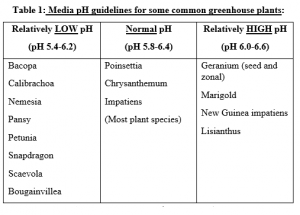
As grouped in the above table, some crops prefer a relatively lower pH. If the substrate pH is too high, these crops will show symptoms of iron and manganese deficiency, most commonly expressed as interveinal chlorosis of the young leaves (Figure 1).
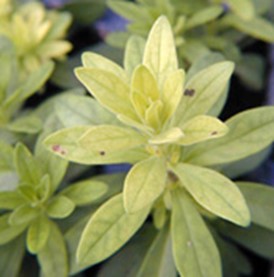
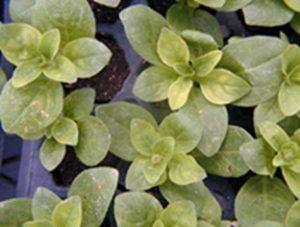
Figure 1: pH too high - Calibrachoa and Petunia plants showing symptoms of iron and manganese deficiency. (Source: https://secure.caes.uga.edu/extension/publications/files/html/B1256/images/B1256-11b.JPG)
Some other crops prefer a higher pH (generally above 6.0), where iron and manganese are less available. If the substrate pH is too low, they will show symptoms of micronutrient toxicity, most commonly expressed as necrotic spots on the lower leaves.
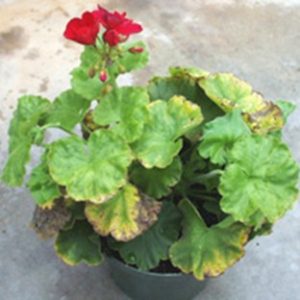
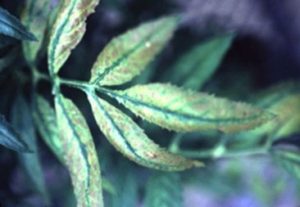
Figure 2: pH too low – Geranium and Marigold plants showing typical symptoms of iron/manganese toxicity. (Source: https://secure.caes.uga.edu/extension/publications/files/html/B1256/images/B1256-11b.JPG)
Other general tips
- Plan and order your growing mix requirements in advance. This will avoid supply delays during peak demand period.
- Also, it is a good idea to request a sample and test it under your growing conditions before you order a new product.
- Moisten the media prior to potting to expand the pore space. Also, pay careful attention when filling pots and trays. Avoid compacting substrate in containers to optimize porosity. Compacting media is not good because it reduce air space Root aeration is very important.
- Most growing media contains a starter fertilizer charges that are incorporated to help plants acclimate after initial planting just sufficient for the initial two weeks. It is important to start a suitable fertilizer management pattern during the crop cycle.
- Test your growing media, irrigation water and plant tissues periodically from a horticulture laboratory during cultivation. Because growing media pH, EC and nutrient content will change with fertilizer application, irrigation water and nutrient uptake by plants. Periodic testing is an invaluable tool to monitor crop requirements and establish growing trends. With lab analyses, growers can make small modifications, if necessary, during the crop cycle to fine-tune cultural practices and achieve the best performance from growing media.
- Optimize the efficiency of your greenhouse air circulation system for healthy plant growth
- Proper greenhouse sanitation reduce the risk of pest, disease and weed problems.
- If you are a “dry grower” (growers who irrigate less water but irrigate more often), leach your growing media few times during production to avoid salt built-ups.
- Check plants regularly for root damage / or for active healthy roots. Root health is a good indicator of overall plant health.
- Keep detailed records on your daily crop management to optimize your cultivation procedures and crop management skills.
- We provide the necessary technical support and/or can produce you a Custom Blend order to meet pH requirements for the crop. Please contact us for details.
